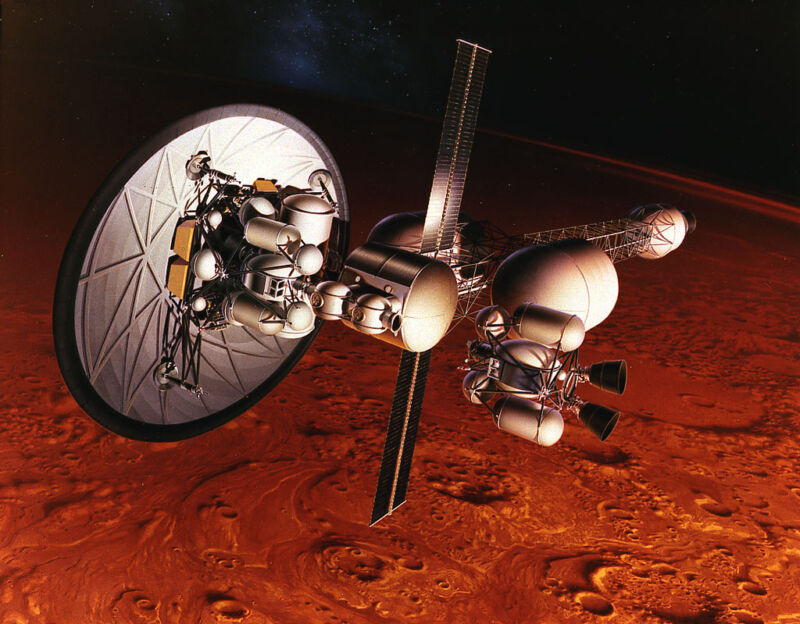
There are many ways to get around space, but most of them are pretty slow. This is why, even when launching at an optimal time, a spacecraft leaving Earth requires about six months to reach orbit around Mars.
For decades, many rocket scientists have looked to a propulsion system powered by a nuclear reactor as the fastest practical means of getting to Mars and other places in the Solar System more quickly.
Wernher von Braun, the German engineer who defected to the United States after World War II, recognized the potential of nuclear thermal propulsion even before his Saturn V rocket landed humans on the Moon with chemical propulsion. Eventually, this led to a project called NERVA, which stood for Nuclear Engine for Rocket Vehicle Application. It was eventually canceled to help pay for the space shuttle.
NASA has supported efforts to develop a nuclear thermal engine in fits and starts since. The basic idea is pretty simple—a nuclear reactor heats a propellant such as liquid hydrogen, and it expands through a rocket nozzle and provides thrust. No such rocket engine has ever flown, however, and at present, NASA is more interested in developing nuclear energy for surface power on other worlds than working on propulsion.
Enter DARPA
But now, the US Department of Defense is getting interested in space-based propulsion. Last month, through a presolicitation, the US Defense Advanced Research Projects Agency announced its intent to have a flyable nuclear thermal propulsion system ready for a demonstration in 2025.
Through this Demonstration Rocket for Agile Cislunar Operations, or DRACO program, the defense agency seeks technology that will allow for more responsive control of spacecraft in Earth orbit, lunar orbit, and everywhere in between, giving the military greater operational freedom in these domains.
"Activity in cislunar space is expected to increase considerably in the coming years," Maj Nathan Greiner, manager of the DRACO Program, told Ars. "An agile nuclear thermal propulsion vehicle enables the DOD to maintain Space Domain Awareness of the burgeoning activity within this vast volume."
In "Phase 1" of its solicitation, DARPA has asked industry for the designs of both a nuclear thermal reactor and an operational spacecraft upon which to demonstrate it. This initial phase of the program will last 18 months. Subsequent phases will lead to detailed design, fabrication, ground tests, and an in-space demonstration. No contracts have yet been awarded, and award values will be determined by industry submissions.
With the DRACO program, the US Defense Department could potentially move large satellites quickly around cislunar space. For example, moving a 4-ton satellite from point A to point B might take about six months with solar electric propulsion, whereas it could be done in a few hours with nuclear thermal propulsion.
To use this technology for Mars missions, NASA would probably want a system with higher thrust. But having DARPA show the way in terms of developing this technology, proving out a lot of overlapping technologies, and demonstrating operation of a nuclear engine in space, would have benefits for NASA down the road. So while the defense department is interested in cislunar space, a successful DRACO test would be good news for human exploration as well.
Converging technologies
DARPA's decision to push forward with development of nuclear thermal propulsion comes as critical enabling technologies are maturing, said Jonathan Cirtain, president of advanced programs at BWX Technologies. Cirtain's company, which makes most of the nuclear reactors found on US Navy submarines and aircraft carriers, is working with NASA on the design of a reactor to enable Mars missions.
One advancement has come in the ability to manufacture refractory metals, which are extraordinarily resistant to heating. To operate efficiently, Cirtain said, an engine must be able to withstand huge temperature and pressure changes across just two meters in length. Hydrogen fuel is stored at just 19 Kelvin and heated to 2,500 Kelvin or higher.
At the same time, engineers designing nuclear reactor cores have access to computational power that allows them to iterate new designs—calculating such variables as neutron flux and fluid dynamics—quickly. "Now, with supercomputers on your desk, you can go from years' worth of calculation time to days, and iterate to a design solution much faster than you could previously," he said.
DARPA has decided that now is the time to capitalize on these maturing technologies.
reader comments
472